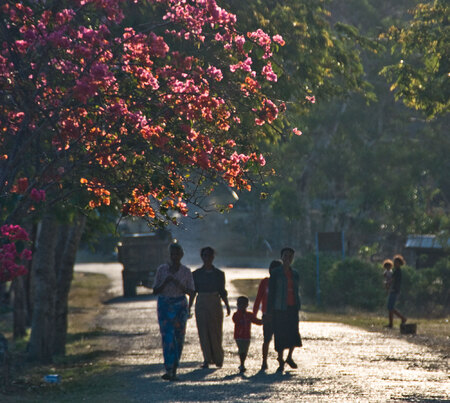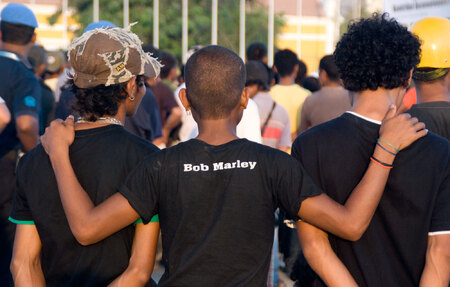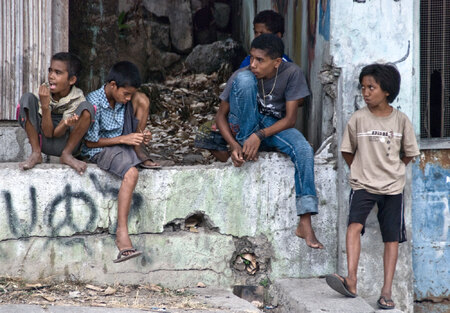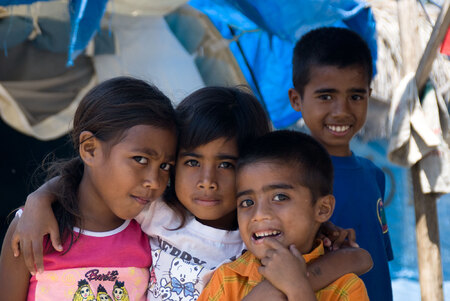[This feature appeared in a somewhat shorter form in the Weekender edition of the Vanuatu Daily Post.]
After decades of violence and suffering, Timor-Leste begins to bloom

There is no view quite so striking in Timor-Leste as a bougainvillea in full flower on a dusty plain. Almost every village house has one, as if to put an exclamation point on the landscape, not simply to announce but to cry out, “I’m here, I’m alive!”
After more than 35 years of violence and catastrophic suffering, at their own hands and those of a cruelly indifferent world, it’s nothing short of a marvel that the Timorese can smile at all. But on September 21st, the world’s youngest nation did just that, and more. For the first time in the country’s history, they gathered to celebrate Peace.
The decision to commemorate International Peace Day this way was a gambit, calculated finely by Prime Minister Xanana Gusmao. When the FRETILIN opposition threatened to ratchet up the cycle of dissent and the potential for violence by holding protest rallies, he beat them to the punch. He, his cabinet, international representatives and over 2000 onlookers gathered openly in the grand square in front of the Palacio do Governo for the celebrations.
Entering the grounds of the Palacio, I expected to encounter a large military presence. But, unlike the FRETILIN, the current administration deliberately avoids any overt show of force. Security arrangements were comprehensive, quiet and discreet.
The festivities were modest, but given Timor-Leste’s brief, tumultuous history, they were as remarkable an affirmation of life as a splash of colour in an arid land.

Timor’s bloom has been as sudden as it is vivid. With its coffers filling with petroleum revenues, the national budget has grown from a paltry $40 million US to over $700 million in just two years. Public works projects are everywhere, with multi-story buildings springing up beside shattered edifices (remnants of Indonesia’s ruinous scorched earth campaign in 1999 which destroyed 70% of the nation’s infrastructure).
One of the biggest challenges facing the government today is how to spend the money at all. Ignoring accusations from other nations and international agencies that they are selling out their legacy, Xanana (as he is fondly known by all) and his cabinet have decided that the development of Timor-Leste can’t wait. They reason that they have a few years at best to change the pattern of respite, dissension and eruption that has characterised the nation since the mid-1970s.
Their approach is practical and direct. With nearly 100,000 internally displaced people still living in camps when they took office, they bridled when presented with long-term comprehensive strategies that envisioned resettlement for the majority after 8 years. The government immediately ordered cash payments to IDPs to help them rebuild their homes. It was a partial answer, one that the government admits will require significant further effort, but the move helped 60,000 people to begin rebuilding within a year.
Despite some softer gains under the joint UN/Timorese administration – peace, improved stability and periods of relative calm – the focus in those early days was very much on building the larger institutions. When power was handed over to FRETILIN movement, things went from bad to worse. Its expertise in guerilla operations and resistance did not translate into competent governance. It was Xanana himself who precipitated their removal by threatening to resign the Presidency unless the increasingly fractious Prime Minister Mari Alkatiri stepped down. He then formed a uniquely Timorese rainbow coalition and has been Prime Minister since last year’s election.
Until recently, there’d been little improvement, if any, in the day-to-day lives of Timorese. Poverty figures rose to staggering levels. Roads fell into disrepair. Health and education services were held together mostly by charities and the Catholic Church, which cemented its integral role in Timorese life during the calamitous 1970s and 80s.
The government had never played a positive role in people’s lives, but Xanana was determined to change that.

Assisted by returned members of the Timorese diaspora, he assembled a mix of politicians and public servants to form his cabinet. Together they’ve embarked on a remarkably ambitious venture – the transformation of a country that’s never known peace into a functioning multi-party democracy.
It’s a difficult prospect, to say the least. Timor-Leste’s modern history is a litany of dashed ideals.
The naïveté of the Timorese political leadership at the outset was tragic in the extreme. Infighting, factionalism and lack of planning led to chaos, which Indonesia was happy to use as a pretext for invasion and occupation. Their manipulation of the nascent independence movement of the 1970s, and the cynical decision by Portugal, Australia, the US and others to look the other way, resulted in an estimated 100-200,000 deaths in the ensuing years.
Led by Nobel laureates Jose Ramos Horta and Catholic Bishop Carlos Belo, the Timorese resistance mastered the craft of international diplomacy in the years leading up to Indonesia’s withdrawal, but once again suffered for relying on an inept and ineffectual UN during the tumultuous days following the 1999 referendum on self-determination.
Once again, Indonesia took advantage of the worst aspects of human nature to set the Timorese against themselves. The fighting and destruction that followed left 1400 dead and over 100,000 displaced.
Xanana’s government has learnt a bitter lesson: Accepting assistance is all well and good; relying on the world to remedy Timor’s ills can only lead to further disaster.
The country’s problems are manifold. The flower of a generation, those men and women who should now be guiding the machine of state, are dead, displaced or disaffected. The majority of youth are unemployed, undereducated and discontented. Every single aspect of the country’s infrastructure needs to be built anew.
But what the government lacks in experience, it makes up for in devotion, energy and – finally – the means to deliver on their promises. The natural gas fields of the Timor Gap are finally in the right hands, and their abundance is making itself felt.
Some of the spending choices leave outsiders scratching their heads in bemusement. At one end of the Palacio do Governo, for example, stands a giant video screen. Every night, street youth and the occasional late-working civil servant gather in the darkness to watch European football. Many have questioned the wisdom of this quarter-million dollar annual expenditure, but when one considers the other things these youth could be doing – and have done in the past – on Dili’s dusty, half-lit streets, the price seems cheap.
It may sound trivial to most of us, but for people to gather together in security and comfort is still replete with novelty in Timor-Leste. Xanana and his cabinet are determined to nurture this first flush of innocence reborn. Like the first tentative bud on a newly planted cutting, they tend it with care.

There are a million more still to look after. The work seems endless, and time is short. Unless Timor’s youth are given stability, peace and a purpose, they will almost certainly re-enact their parents’ descent into rancour and destruction. The world didn’t save them last time, and there’s no reason to believe it would again.
Timor-Leste is saving its own life, with little insight or assistance from the outside world. But like a bright flower in an arid land, this sudden outburst of life is an arresting sight. Or would be, if the world would stop to look.

Nice story. I hope these beautiful people finally find the peace they fought so hard for.
The story is inspirational and motivating. I love it.
Preaty good overview,….I hope one day my Homeland become second Singapure in South East Asia. Timor Leste must lead by it’s indgenous Leader not Arab Imigrant because the imigrant they don’t have the sense of belonging to Timor Leste,he just want to take advantage of the resources to enrich his own and left east timorease become poor and under developed. Exemple when east timor invade by Indonesia the Arab Imigrant run away to Maputo, we never heard his name during the struggle only our brother Xanana he suffer and lead the struggle until the end. It is worthfull experience for us to do not trust and give our country to Arab Imigrants to lead becuase they don’t have nationalism as indigenous Timorease Leaders.
Aifunan Ramelau
nice one
Nice article. It is true we have to be optimistic even within a dusty and dark room. The timorese flower is always blooming. That the reason for their suffering caused by the international politics, the big guys who own the world. The timorese should work hard in a solid unity, and leave politics of divisiveness. The timorese garden full of flowers, they should take care of it in order the flowers cannot be wither but always blooming
What a fabulous reflection!
Awesome!
Cheers
It is a nostalgic account of the recent history, thus far we are all puzzled by the overwhelming contribution from these so called Diaspora contingent “Brothers, sista – cousins TIOS , TIAS…etc…etc…etc…”THE “ leader also placed a so called “Corruption Committee” to look after the corrupt??!! Or visa-versa…well in some areas, by having Count Dracula taking care of the BLOOD Bank is a very wrong move! Maromak tulun Ita hotu Timor Oan.